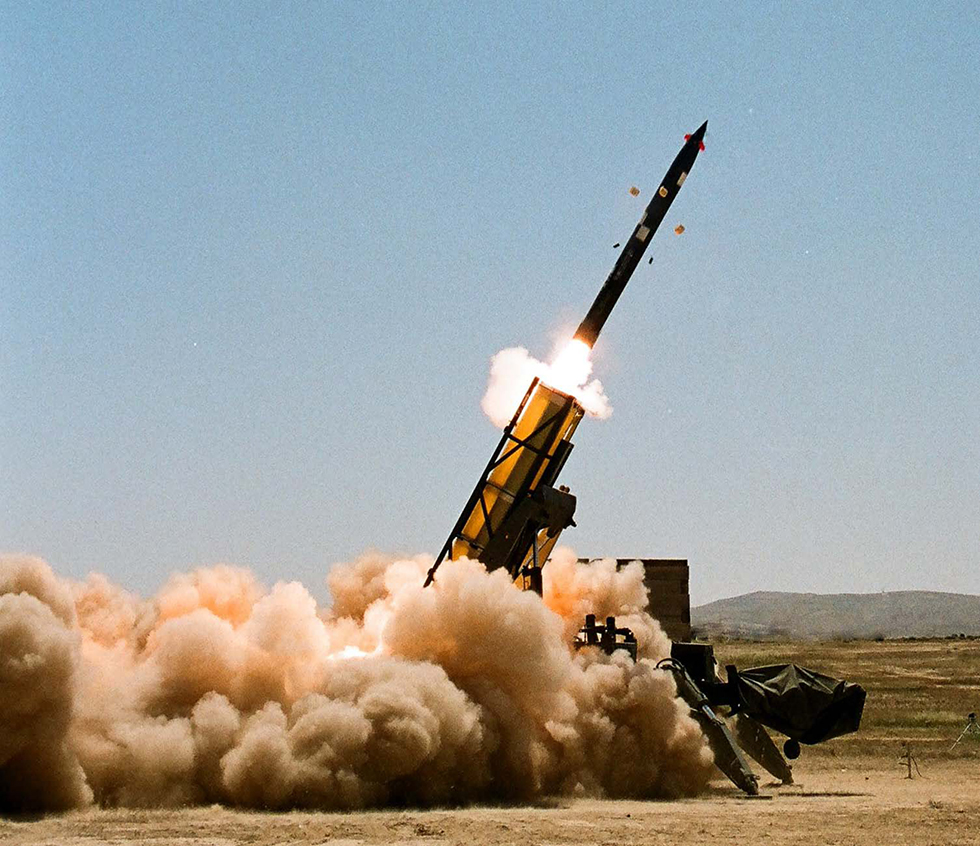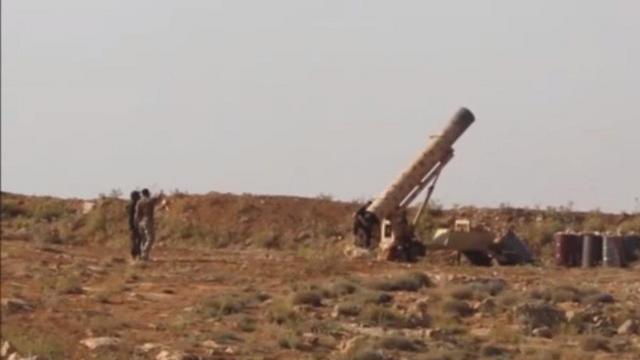

Introducing the IDF’s new ‘missile corps’
After a long-standing debate and objections from senior General Staff members, Defense Minister Lieberman has decided—in full agreement with Chief of Staff Eisenkot—to build a surface-to-surface missile arsenal in the Ground Forces; within two years, Israel Military Industries will supply missiles with a range of 150 kilometers and the ability to destroy any target within five minutes, which will later be joined by missiles covering all of Lebanon and reaching deep into Syria as well.
This dramatic decision, which is being revealed for the first time, contains the seeds of the next revolution in the IDF’s combat doctrine. The plan is to build an effective medium-range surface-to-surface missile arsenal as part of the IDF’s current work plan, which ends in 2020. And before anyone could change their mind, the defense minister rushed to allocate about NIS 500 million (roughly $145 million) for the project—as a first course—from the defense budget.
For decades, defense establishment officials have been arguing about the need for a military arm to activate surface-to-surface missiles to a range of 150-300 kilometers. The debate has gotten very heated, particularly in light of the “threat” to the Israel Air Force’s monopoly as a long-range strategic arm.
During the discussion in the defense minister’s bureau in early January, there were some senior IDF General Staff members around the table who didn’t like the idea. Lieberman, in full agreement with Chief of Staff Gadi Eisenkot, decided to end the long-standing debate and to adopt a plan prepared by the Planning Directorate in the past six months.
According to the plan, the first stage would include the creation of an arsenal of surface-to-surface missiles with a 150-kilometer range, which would be operated by the Ground Forces. The army would use an existing product: Missiles of the EXTRA model, which the Israel Military Industries (IMI) company manufactures for foreign armies.
At the same time, the Navy’s warships—Sa'ar 5-class corvette and Sa'ar 6-class corvette—would be armed with these missiles and become part of the IDF’s strategic arm. According to the work plan, the missiles would be adapted by IMI for the Air Force too. In more advanced stages of the plan, missiles with a range of 300 kilometers and more would be introduced into the arsenal as well.
The final price tag remains unclear. It could reach about NIS 7 billion over a decade—depending on the number of missiles the IDF will arm itself with. This is also the plan’s weak spot: If there are not enough missiles to wage a long battle, this will hardly be a revolution.
1,000 precision-guided missiles
Lieberman came up with idea to establish a strategic arm in the Ground Forces way before entering the Defense Ministry. In 2004, as an ordinary Knesset member, he wrote a book called “My Truth,” in which he explained the need for such an arm. Over the years, he repeated the idea as a member of the Political-Security Cabinet and as chairman of the Knesset’s Foreign Affairs and Defense Committee. Now, he has the ability to implement it.
But in 2004, when Lieberman wrote his book, there was no operative need for a missile arsenal in the Ground Forces. Furthermore, the technology—which turned cheap rockets with a statistical destruction ability into accurate missiles—had yet to mature. The enemy was different, and the Air Force could provide a fully response to the remote targets.
The dramatic change in the Israeli military perception took place about five years ago, as a result of global technological developments, when Western countries lost their monopoly over precision-guided arms.
Five years ago, Iran succeeded in developing a flight correction and navigation kit, which is applied to “dumb” Iranian-made rockets and turns them into precision-guided missiles. This raised concerns in the Israeli defense establishment that Iran would turn the dumb rockets in Lebanon into precision-guided missiles. And sure enough, instead of transporting missiles to Lebanon through Syria, Iran is preparing to assemble navigation kits on the dumb rockets that are already in Lebanon. This does not require any huge factories.
Israeli officials believe that within a decade there will be more than 1,000 precision-guided missiles in Lebanon. Each of them, if launched, will accurately hit its target or miss it by just a few meters. This could cause enormous damage to the IDF’s intelligence and control systems and to IAF bases, and in fact to all the systems supporting the army’s quick response abilities, not to mention the damage to national infrastrctures: Electricity, water, government symbols like the Knesset, the government, the Kirya Base, etc. Even if we assume that the Iron Dome system is capable of intercepting 90 percent of these missiles, there will still be about 100 accurate missiles left that could hit vital targets and inflict, alongside the destruction, heavy damage to morale.
We are entering a new era in which Hezbollah possesses precision-guided rockets covering most of Israel’s territory, and this is what prompted the prime minister, the defense minister, the chief of staff and the IDF spokesperson to take every opportunity to threaten Lebanon with war in recent days.
Up until a few years ago, we were able to say: The Air Force is purchasing planes as it is; each of them can carry 24 guided bombs with a much heavier warhead than the warheads of the relatively expensive surface missiles; the air bases exist; the teams exist; the IAF is capable of destroying thousands of targets in one day, and has intelligence gathering abilities for those targets. So who needs a missile arm in the Ground Forces? It would be the wrong thing to do financially as well.
But that has all changed. The huge improvement in anti-aircraft weapons, some of which are already in Syria, along with the enemy’s large amount of precision-guided missiles, require the army to divide the tools at its disposal between the IAF, the Ground Forces and the Navy.
While continuous accurate missile fire on Israel’s air bases won’t paralyze the Air Force, which is prepared to deal with such a scenario, the IAF’s effectiveness is also measured through its ability to produce a series of sorties. It’s very likely that the IAF’s functional continuity will suffer in certain timeframes. In such an event, the cheap bomb on the plane’s wing becomes quite irrelevant.
In the era of precision-guided rockets, Israel has to have the ability to attack from the very first moment, rather than wait for reserve forces to be called up, for the ground forces to prepare for a ground invasion, for the Air Force to gain strength. Military officials admit that the move being led by the defense minister and chief of staff should have been implemented quite a few years ago.
There is a diplomatic aspect too. Foreign armies, for example. When Israel sends out planes in response to hostile activity, it risks clashing with the Russian air defense system or with Russian pilots. A precision-guided missile launched from the ground won’t get Israel entangled in such a conflict. It will hit the target and destroy it.
The short-range missile arsenal could be critical in the first hours of fighting. Here’s a possible scenario: Two IDF soldiers are kidnapped into Lebanon. Within less than a minute of receiving the order, even before a force crosses the border in pursuit of the kidnappers, all the bridges on the Litani, Hasbani and Zahrani rivers—whose coordinates have already been fed into the systems—are destroyed to prevent them from fleeing northward.
When reserve soldiers Ehud Goldwasser and Eldad Regev were kidnapped in July 2006, the pursuing force didn’t have any accurate air cover and the attack helicopters arrived after the kidnappers had already slipped away.
When the AccuLAR-122 missile system with a 40-kilometer range—which the Artillery Corps received last year—reaches its full force, it will be able to launch some 300 missiles every 10 minutes at any target south of the Zahrani River—in other words, 300 targets will be hit by accurate fire every 10 minutes.
There are 237 villages in southern Lebanon with thousands of targets. The first barrage will destroy the rockets and regular launchers at sites the Israeli intelligence is familiar with, as well as Hezbollah’s control and command posts. By the time the Air Force reaches a critical mass of air crews, Israel will have an effective response to the missile barrages launched from southern Lebanon. Hezbollah is already capable of firing more than 1,200 missiles, some of them accurate, in the first barrage. The response, therefore, must be immediate.
Once the IDF has missiles with a range of 150 kilometers, it will be able to launch from some point in the north, far from the border, hundreds of missiles covering targets north of Beirut or Damascus. In the event of a missile attack on Israel, targeting the Kirya and the Knesset, a first missile will hit a defined target in the Lebanese capital within five minutes of receiving the order.
One system can carry out five barrages in one hour, with eight missiles per barrage—in other words, 40 missiles an hour. Multiply that by 10 launchers, and you’ll have more than 400 missiles fired at Beirut every hour. The precision level of these missiles is just a few meters. An EXTRA missile fired from the Golani Interchange, for example, could destroy a certain floor in a Beirut building—even before the planes take off. This type of punishment could create deterrence.
The next stage in building the arsenal is surface-to-surface missiles with a range of 300 kilometers and more. Such a missile, called Predator Hawk, is already in advanced stages of development and testing by the IMI.
The AccuLAR-122 insurance policy
The IDF was aware of these scenarios and abilities, but no one was in any rush. In 2012, the National Security Council ordered the Planning Directorate to prepare a plan for the creation of a rocket and missile corps, in light of assessments that the enemy had obtained precision-guided weapons. The Planning Directorate prepared the plan with a clear lack of interest.
The years 2012 and 2013 were particularly difficult budget-wise. There were discussions on allotting NIS 2-3 billion for the establishment of units and the purchase of equipment and missiles. No one knew where the money would come from.
Nevertheless, the General Staff was troubled by the Hezbollah accurate missile threat, at least from the artillery perspective, and searched for missiles with 20 to 40-kilometer ranges, which would assist in the ground battle, mainly on the division level. In the Artillery Corps at the time, there was one big system of precision-guided missiles with a range of 30 kilometers that had been purchased in 2005 and were called “trajectory correction rockets”—the American MLRS rocket, which already existed in the IDF and which was made accurate by IMI through Elisra radar systems. This system’s first operational test was in the Second Lebanon War, when 140 of these rockets were fired, mainly at Hezbollah gatherings.
At the same time, the IMI introduced LORA ("Long Range Artillery"), a surface-to-surface missile with a range of more than 300 kilometers, maximum accuracy and an ability to penetrate fortifications. As far as the IAF was concerned, this missile was like a desecration of something holy.
In 2013, in light of the alarming intelligence from Lebanon, the army purchased the AccuLAR-122 missile system—a precision-guided rocket with a range of 40 kilometers—from the IMI. The Artillery Corps completed the creation of the first operational unit this year. During an operational test of the AccuLar-122 system, three missiles were fired at three different targets dozens of kilometers away within 12 seconds. All three targets were destroyed.
Nevertheless, the AccuLar-122 purchase, as well as the purchase of trajectory correction rockets, was seen as an addition of an accurate fire-delivering force to the artillery rather than as part of a strategic surface-to-surface missile arm which would operate alongside the Air Force and serve as an “insurance policy” in case the aerial activity sequence was cut off, even briefly. The number of rockets that were purchased also matched the perception of merely an additional accurate fire-delivering force.
Unlike the Iron Dome system, which required a long and expensive development process, the EXTRA missiles are on the IMI’s shelf and have been manufactured and sold since 2010. A considerable number of armies in the world have regiments of missiles produced by the Israeli company, which are supplied in full—including a command car, an intelligence-gathering RPV, control and command systems, a location system, vehicles and of course the missiles themselves. These GSP-guided missiles, which have the unique IMI flight-correction abilities, come in standard packaging, so the launcher—dubbed “crusher”—can hold both short-range and long-range missiles. Changing the packaging is a matter of 10 minutes.
In December 2013, the government decided that IMI Systems would be the exclusive manufacturer of precision-guided rockets in Israel, so the army wouldn’t have to choose between manufacturers. But when it came to the purchase of missiles beyond a 40-kilometer range, someone from the outside apparently had to break the army’s mindset. Moshe Arens, as a civilian defense minister, forced the establishment of the Ground Forces Headquarters, which eventually turned into the GOC Army headquarters; Amir Peretz, as a civilian defense minister, decided in favor of the Iron Dome system, and Liberman is now pushing for the establishment of a surface-to-surface arsenal.
According to the GOC Army headquarters’ demand, the missile arsenal with a range of 150 kilometers—and in the future, if purchased, a range of 300 kilometers as well—will be found in special support units designated for fighting deep within enemy territory. The Artillery Corps wants these missiles too. No decision has been made yet.
It’s clear, however, that these missiles will only be operated by the General Staff. The Artillery Corps’ arsenal is aimed at aiding the division maneuver. Ranges of more than 40 kilometers require a different kind of intelligence and decisions on the General Staff and political echelon level.
Meanwhile, the fear in the Ground Forces is that one day, when it’s time to pay for the development of the missile arsenal, there will be no one to pull out the checkbook and the revolution will turn into an unimportant episode. After all, we used to have American surface-to-surface Lance missiles, which ended up rotting in the warehouses.


















